- There are no more items in your cart
- Shipping Calculated at checkout
- Sub-Total (inc. VAT) £0.00
Need Help?
Rust Converters
Rust converters are vital chemical solutions that transform active rust into a stable, non-reactive layer, preventing further corrosion on metal surfaces. The innovative nature of these products lies in their ability to chemically convert iron oxide (rust) into a more stable form such as iron tannate. This layer not only halts the degradation process but also prepares the surface for painting and further treatment. Unlike traditional methods that require the complete removal of rust through sandblasting or grinding, rust converters save time, reduce effort, and limit the risk of damaging the metal substrate underneath. Click for more info.
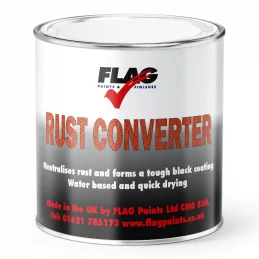
Flag Rust Converter
Flag Rust Converter is a high performance water based low odour and environmentally friendly primer treatment which neutralises rust and forms a tough black surface. It prevents rust re-occurring and is quick drying and easy to use.For interior and exterior use Suitable for over-coating with solvent based primers or top coats For use on...
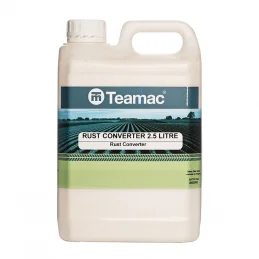
Teamac Rust Converter
Corrosion inhibitor and rust converter. Dries to a black finish. Ideal for use on iron and steel where rust cannot be fully removed. Non-flammable with a low sheen finish.
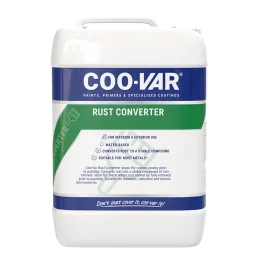
Coo-Var Rust Converter
Designed to convert rust on iron and steel surfaces. Darkens upon drying. For iron, weathered steel, structural metalwork, and tools. Non-flammable with a low-sheen finish.
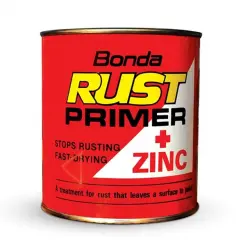
Bonda Rust Primer
Bonda Rust Primer is a resin-based zinc anti-rust coating treatment. It forms a tough skin with a bonded in anti-rust system for a long-term action. It has excellent adhesion to most metals and leaves a primed surface ready to paint with all types of paint.Stops rusting Fast drying Used to stop further corrosion Leaves a paintable...
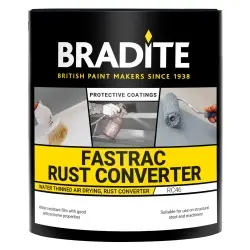
Bradite Fastrac Rust Converter
Bradite Fastrac Rust Converter is a high performance, single-pack, water-based rust converter intended for the treatment and passivation of surface rust on all hand or mechanically prepared rusty ferrous surfaces.Especially suited for objects which may be difficult to sand blast such as; fences, iron railings, guttering and outdoor...
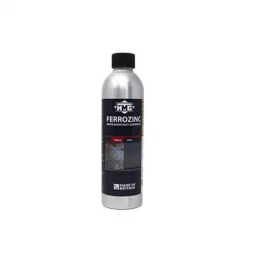
HMG Ferrozinc Rust Converter
HMG Ferrozinc Rust Converter is a high performance water-based rust converter, ideal for application to areas difficult to shot-blast or where total removal of rust is not possible. Also suitable for surfaces difficult to dry due to existing moisture.Easily applied single pack material Changes colour to show rust has been neutralised...
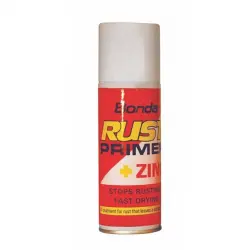
Bonda Rust Primer - Aerosol
Bonda Rust Primer - Aerosol is a rust prevention primer containing anti-rust zinc. A treatment for rust that leaves the surface ready to paint.A resin based zinc anti-rust coating Forms a tough skin Anti-rust system for a long term action Excellent adhesion to most metals Leaves a primed surface ready to paint with all types of paint...
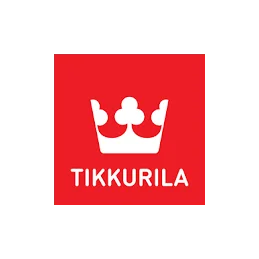
Tikkurila Rust Converter
Tikkurila Rust Converter, a water-borne metal primer for rusty areas - Rust Converter encapsulates the rust and prevents it from spreading.Suitable for rusty surfaces of iron and iron alloys To be used only on rust Must be coated with Metal Primer WB or Isoxyde
Need Help?
Need Help?
These specialist rust converters are especially beneficial in industrial and commercial sectors, where large-scale metal structures or machinery are exposed to the elements. They are widely used in industries where corrosion can compromise the structural integrity or functionality of equipment, such as the automotive, construction, marine, and agricultural sectors.
Top Features and Benefits of Rust Converters
When choosing a rust converter, it's crucial to understand the key features that make these products invaluable for both small and large-scale projects. Rust converters provide numerous advantages over traditional rust removal techniques, including:
- Chemical Transformation: One of the core benefits of rust converters is their ability to chemically neutralise rust, turning it into a stable and inert substance. This eliminates the need for aggressive rust removal methods, protecting the integrity of the metal surface.
- Time and Labour Saving: Traditional rust removal often involves mechanical processes like sandblasting, scraping, or grinding, which can be time-consuming and labour-intensive. Rust converters simplify the preparation process by allowing users to apply a liquid or gel directly to the rusted area, transforming the rust in place.
- Long-lasting Protection: Rust converters not only stop current rust but also provide a protective layer that slows down further corrosion. This extends the lifespan of the treated metal and reduces the need for frequent maintenance, making them an ideal solution for long-term applications.
- Paintable Surface: Once the rust is converted, the surface becomes ready for painting or priming. This paintable layer enhances adhesion, allowing subsequent coatings to bond more effectively, which is essential for outdoor and exposed metalwork where an additional protective layer is needed.
- Versatility in Application: Rust converters can be applied to a wide range of metals, including ferrous metals commonly found in industrial settings. They are effective on both lightly rusted and heavily corroded surfaces, making them suitable for various levels of rust damage.
- Eco-friendly Options: Many modern rust converters are formulated to be environmentally friendly, using less harmful chemicals compared to older rust removal methods. This is especially important for industries seeking to minimise their environmental footprint while still requiring effective corrosion control.
- Prevention of Further Corrosion: By creating a barrier over the rusted area, rust converters prevent oxygen and moisture from reaching the metal surface, significantly reducing the chances of new rust forming.
- Ease of Use: Rust converters are easy to apply with standard brushes, rollers, or sprayers, making them accessible for both professional and DIY users. The simplicity of application reduces the need for specialised equipment or techniques.
- Cost-effective: Due to their ability to save on time, labour, and the need for extensive equipment, rust converters are a more cost-effective solution compared to traditional rust removal and prevention methods.
Common Uses for Rust Converters
Rust converters serve a wide variety of industries and applications due to their versatility in halting corrosion and preparing metal surfaces for long-term protection. While they are frequently employed in common sectors like automotive and construction, their usage extends to highly specialised fields such as historical preservation and aviation. This section delves deeper into where and why rust converters are applied, emphasising their importance across different industries.
Automotive Repair and Maintenance
The automotive sector heavily relies on rust converters for both routine maintenance and restoration projects. Cars, trucks, and other vehicles are particularly susceptible to rust due to exposure to moisture, road salt, and grime, especially in areas like the undercarriage, wheel wells, and chassis. Rust not only damages the vehicle’s appearance but also weakens critical structural components over time, compromising safety and longevity.
Rust converters are used to treat corroded areas without the need for intensive mechanical rust removal, making them ideal for DIY enthusiasts and professional garages alike. The ease of application ensures that parts such as brake lines, exhaust systems, and suspension components can be protected without disassembly. In the case of classic car restoration, rust converters play an essential role in preserving the original integrity of the vehicle by stopping further corrosion on body panels, frames, and other key parts. Their ability to create a stable, paintable surface allows for a smooth transition from rust treatment to priming and painting, which is crucial in both aesthetic and functional restorations.
Marine Industry and Coastal Applications
The marine environment is particularly hostile to metals, given the high salt content in the air and water. Rust converters are widely used in the marine industry to protect ships, boats, and metal structures like piers, jetties, and offshore platforms. Saltwater accelerates the rusting process, often leading to significant damage if left untreated.
In addition to treating rust on hulls, decks, and structural components of vessels, rust converters are also used on dockside equipment, metal pilings, and storage tanks exposed to the sea. Their chemical transformation of rust into a stable layer prevents further corrosion and prepares the surface for protective coatings, which are essential in these high-risk environments. This protective step is not only vital for the longevity of the metal structures but also for the safety of operations, especially on ships and oil rigs where compromised structural integrity could lead to catastrophic failures.
Furthermore, the application of rust converters in coastal infrastructure is critical for bridges, fences, and steel buildings located near the sea. The products provide a cost-effective solution for extending the lifespan of these structures, delaying the need for expensive replacements or repairs.
Construction and Infrastructure
In the construction industry, rust converters are commonly applied to structural steel, bridges, and other metal frameworks. These metal components are often exposed to the elements, making them prone to corrosion, especially in outdoor or unprotected settings.
Rust converters are especially useful during maintenance work on bridges, scaffolding, and metal frameworks, where removing rust mechanically might be impractical or unsafe. By treating rust in place, rust converters help maintain the structural integrity of metal beams and supports, ensuring that buildings, towers, and bridges remain safe for use over extended periods.
An increasingly common application is in prefabricated steel structures, where rust converters can be used to treat exposed metal before installation. By applying the converter prior to transportation and erection, construction companies can ensure that steel components arrive on-site with a protective layer already in place, reducing the likelihood of rust developing during the assembly process.
In addition to these applications, rust converters are also used in maintenance projects for railings, gates, and metal fences that are constantly exposed to harsh weather conditions. Their ease of use and ability to bond with existing rust make them an indispensable tool for the construction and maintenance of both public and private infrastructure.
Agricultural Machinery and Equipment
Agricultural machinery such as tractors, ploughs, harvesters, and trailers are often subjected to rough outdoor environments where dirt, moisture, and agricultural chemicals accelerate rust formation. Rust converters are widely used in the farming sector to protect these valuable pieces of equipment from further degradation, ensuring that they remain functional throughout the growing season.
Rust converters are especially beneficial in this sector because of the difficulty and expense involved in replacing large machinery. By applying rust converters to critical parts such as plough blades, wheels, and engine components, farmers can extend the operational life of their machinery. Additionally, these converters help prevent rust from spreading to more vital internal parts, which could lead to costly breakdowns and repairs.
In rural settings where farmers may need to perform maintenance themselves, the ease of applying rust converters without specialised tools or equipment makes them a convenient and effective option for ongoing protection. Barn doors, metal gates, silos, and storage sheds can also benefit from rust converters, ensuring that metal surfaces remain intact and rust-free despite harsh outdoor conditions.
Historical Preservation
In the field of historical preservation, rust converters are invaluable for conserving metal artefacts, monuments, and heritage structures. Unlike modern construction materials, which can often be replaced or repaired, historical metalwork requires delicate treatment to retain its original form. Rust converters offer a non-invasive method of stabilising rust, preserving the appearance and integrity of the metal without damaging its historical value.
Many heritage sites feature iron railings, gates, and structural supports that are several hundred years old. Traditional methods of rust removal could compromise the metal, but rust converters allow for treatment without disturbing the original material. Once the rust is stabilised, protective coatings can be applied to prevent further corrosion, ensuring that these artefacts are protected for future generations.
Additionally, the use of rust converters in the restoration of antique cars, machinery, and tools is critical for preserving these historical items in museums or private collections. By halting the corrosion process, restorers can retain the original metal while preparing it for display or functional use.
Railways and Transportation Infrastructure
The railway sector is another area where rust converters are applied extensively. Rail tracks, bridges, and metal components of trains are constantly exposed to moisture and the effects of wear and tear, making them prone to rust. Rust converters play a crucial role in maintaining the integrity of rail infrastructure, preventing accidents or failures caused by weakened tracks or supports.
In addition to rail tracks, rust converters are used on the metal framework of train carriages, signalling equipment, and overhead line supports. By stabilising rust on these critical components, railway operators can ensure the safe operation of trains and minimise downtime due to repair or replacement needs.
Rust converters are also useful in maintaining transportation infrastructure, such as tunnels, bridges, and overpasses. These structures are often exposed to moisture, salt, and pollution, all of which accelerate rust formation. The use of rust converters allows for the treatment of large metal surfaces without the need for disassembly, saving time and costs while extending the life of the infrastructure.
Aviation and Aerospace
In aviation, rust converters are employed to treat metal parts that are subjected to the harsh conditions of flight, including exposure to varying temperatures, moisture, and air pressure. Aircraft must meet strict safety regulations, and rust converters help to maintain the structural integrity of metal components like airframes, landing gear, and engine parts.
The use of rust converters in the aviation industry helps to prevent rust from weakening critical parts, which could lead to dangerous malfunctions. By treating rust before it can cause severe damage, maintenance crews can ensure that aircraft remain safe and airworthy.
In aerospace, rust converters are also used in the construction and maintenance of satellites, rockets, and other space-bound equipment. These components must withstand extreme conditions, and rust converters provide an additional layer of protection against corrosion, even in the vacuum of space.
Industrial Equipment and Warehousing
In industrial settings, rust converters are used to protect storage tanks, metal pipes, and machinery from corrosion caused by moisture, chemicals, and environmental exposure. Factories, warehouses, and manufacturing plants often house equipment made from steel or iron, which is prone to rusting over time.
Rust converters are commonly applied to large metal surfaces that would be costly or impractical to replace, such as metal roofs, tanks, and pipelines. They provide a quick and effective method of stopping rust in its tracks, reducing the risk of leaks, structural failures, or breakdowns in critical systems.
In warehouses, rust converters are also used to protect shelving units, metal doors, and loading docks. These metal structures are constantly exposed to wear and tear, and rust can quickly compromise their strength. By using rust converters, warehouse operators can ensure that their equipment remains functional and secure, even in challenging industrial environments.
FAQs about Rust Converters
What are rust converters, and how do they work? Rust converters are chemical treatments that transform rust (iron oxide) into a stable compound, such as iron tannate. They work by reacting with the rust to create a black, inert layer that prevents further corrosion and can be painted over.
Can rust converters be used on all types of metals? Rust converters are specifically designed for ferrous metals, such as iron and steel. They are not effective on non-ferrous metals like aluminium or copper, as these materials do not rust in the same way.
Is it necessary to remove all the rust before applying a rust converter? No, rust converters are designed to work on surfaces with existing rust. However, loose or flaky rust should be removed with a wire brush or sandpaper before applying the converter to ensure better adhesion.
How long does it take for rust converters to work? The curing time for rust converters can vary depending on the product and environmental conditions, but most rust converters take between 24 to 48 hours to fully react with the rust and dry into a stable surface.
Can a rust converter be applied over paint? Rust converters should only be applied directly to rusted metal surfaces. Any paint on the surface should be removed to ensure the converter can react with the rust.
Are rust converters suitable for outdoor use? Yes, rust converters are often used outdoors, especially in construction, marine, and infrastructure projects where metal is exposed to the elements. They are formulated to withstand harsh conditions and provide long-term protection.
How long does the protection from a rust converter last? Once applied, rust converters provide long-lasting protection by neutralising rust and creating a barrier that prevents further corrosion. However, for best results, it is recommended to apply a primer and topcoat after using the converter.
Can rust converters be used in conjunction with other rust treatments? Yes, rust converters can be used alongside other treatments like rust inhibitors or protective coatings. It’s essential to ensure compatibility between products, so consulting with a technical support team is advisable.
What is the difference between a rust converter and a rust remover? Rust converters chemically alter rust into a stable substance, whereas rust removers physically strip the rust from the surface. Rust removers are more aggressive and may require mechanical action, while converters are less invasive and work directly on the rusted area.
Can rust converters be used in extreme temperatures? Most rust converters work best in moderate temperatures, typically between 10°C and 30°C. Application in extreme cold or heat may affect the product’s performance and curing time, so always check the product guidelines for optimal use conditions.
For assistance in selecting the right rust converter for specific applications, contact the technical support team for expert advice on product compatibility.
What Rawlins’ Customers Say
Don’t just take our Technical Support Teams’ words for it, here’s what our customers have to say about rust converters they have purchased from our store:
The information provided above is a basic overview and is intended as general information only. It is not advice, and is given without warranty. You should always refer to the relevant data sheets and our Technical Team prior to purchase or use of any products.
